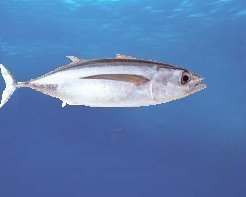
Albacore Tuna are not only found in New Zealand waters, they occur worldwide in warm seas. They are also widley distributed in the Pacific Ocean.
Tuna are also known for their very high swimming speed and keen fighting ability.
The color of the Albacore tuna are a dark blue on top, with a lighter underbelly. They usually have this kind of shading because they are commonly found near the water's surface and live in the open ocean.
Albacore can be recognized as such by the extraordinarily long pectoral fin. This is the fin located on each side of the body and stretches over thee-fourths the length.
Albacore tuna swim near the surface together in loose formations for the first years of their lives. Then, when the albacore get older, they become more independent and spend most of their time in deeper, cooler waters.
Young Albacore grow quickly and remain near the surface of the ocean for their first three or four years.
The survivors of a single spawning often swim and feed together in schools. Some of these schools may contain several species of young tunas, for the young generally prefer the warmer surface waters while the adults seek the cooler temperatures of the depths. This schooling behavior may protect the young because the constantly shifting and shimmering mass of the school makes it difficult for a predator to single out an individual to attack.
The Albacore tuna remains in the surface schools for about five years. Then, for unknown reasons, it abandons the schools and becomes a more solitary, deepwater swimmer.